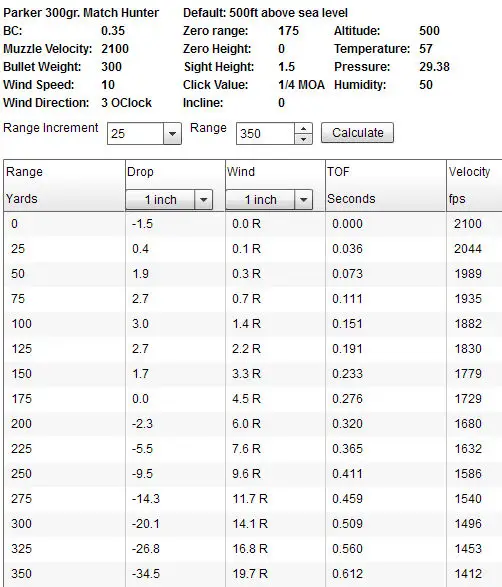


Muzzleloader Bullet Ballistic Coefficients
The
single-number static ballistic coefficients, using the “G1”
flight model, are horribly wrong. If the correct flight model was used
for modern projectiles, ballistic coefficients would not change appreciably
based on velocity. They do, though, which is why the common G1 ballistic
coefficient is so terribly flawed.
The
Krupp artillery round had a B.C. of 1.0 and the Krupp firings of 1881
was the basis for the “Ingalls' Ballistic Tables” computed by
Colonel James M. Ingalls, U.S. Army, 1893, revised under direction of
the Ordnance Board, 1917, at the Sandy Hook Proving Grounds. Previously,
Gen. Mayevski “formulated laws of air resistance,” which were
then extended to higher velocities by Colonel Zaboudski to higher velocities.
After WWII, the ballistic tables were further refined and the “G1”
has been in popular use ever since. There are over a dozen flight models
in use, including:
G6.1 - For flat based "spire point" type
bullets - 4.81 calibers long with a 2.53 caliber nose and a 6.99 caliber
secant nose ogive
G7.2 - For "VLD" type or pointed boat tails - 4.23 calibers
long with with a .6 caliber long 7° 30' Tail Taper and a 2.18 caliber
long nose with a 10 caliber tangent nose ogive. Most modern US military
boat tailed bullets match this model.
G8.1 - Flat base with similar nose design to G7 - 3.64 calibers long
with a 2.18 caliber long nose and a 10 caliber secant nose ogive.
The US M2 152 gr .30 cal bullet matches this drag model.
The short version is that published G1 ballistic coefficients are wrong, as they are not derived from the bullet designs they are applied to. The G7 fight model is often more appropriate, but the “G7” model isn't used very often, as the number is lower than a G1 number, and touting high B.C. numbers sells bullets, or just plain lying about them as Doc White has often said.
Even a “correct” drag model varies widely in concert with temperature, altitude, humidity, and so forth, so unless we are always shooting or hunting in a laboratory atmosphere, even a proper flight model is not precise as used in the field.
None of this is exact, by any means, so the best that can be hoped for is a realistic starting point to work from, that we can confirm in our own rifles, at our own velocities, under our own ambient conditions. For the Parker Match Hunter 300 grain projectile, here is that starting point, based on a G1 ballistic coefficient at 2100 fps.

Closer is always better, of course, and invariably the vast majority of deer taken in North America every year are harvested inside 100 yards. In the case of a lot of hunting in thick woods, you can't see much past 75 yards, and even if snow lights up the woods for you a bit, you'd need a magic meat-seeking bullet to slither its way through all the trees. A deer 100 yards in is usually pretty darn safe. Another consideration is wind drift, for unless you have a string of air socks or wind flags all around you, there may be far too much guesswork involved to be able to take a confident, ethical, long range shot with a muzzleloader. That's all up to you, of course.
This caribou was taken at around 185 yards, as close as I could get for I was fresh out of cover. That was hunting much of the day in the rain, but the rain let up right before the stalk. The wind was brutal, gusting up to 45 mph, and some hunters spent the night inside their boat on the tundra, for the water was treacherous. We made it back to camp, barely, but I've never bailed that fast before in my life. Anyway, unlike the more tricky canyon winds, the wind was all in my face, so no wind doping was needed. It all depends on what your own hunting field conditions may or may not be.
Hornady
sums up ballistic coefficients as follows:
There is no such thing as an absolute and invariable ballistic coefficient (B. C.).
Ballistic coefficients are only one factor in bullet selection for different kinds of shooting.
A ballistic coefficient can change with reference to (1) altitude, (2) temperature, (3) atmospheric pressure, and (4) relative humidity.
Ballistic coefficients are measures of a bullet's relative efficiency.
Ballistic coefficients are not measures of a bullet's "goodness."
Higher B.C.s do not necessarily make a bullet "better."
Lower B.C.s do not necessarily make a bullet "worse."
While
Hornady got most of it right, the last three statements would make more
sense had they referred to "Calculated and Published Ballistic Coefficients."
A more ballistically efficient bullet at the same launch velocity as a
lower shooting B.C. bullet has less drop, less wind drift, and higher
strike velocity. Less drop and wind drift means quicker, easier, more
precise shot placement and there is no substitute for that. At 50 yards,
it may not matter much to you or anyone else. At 250 yards, it most assuredly
does.
Copyright 2014 by Randy Wakeman. All Rights Reserved.

Custom Search


